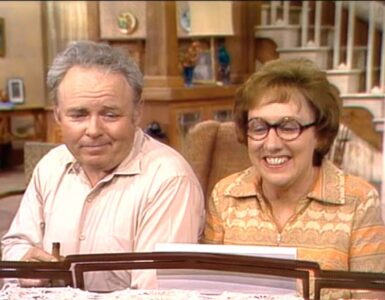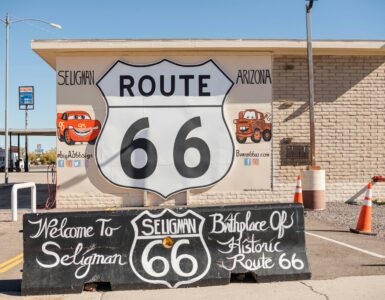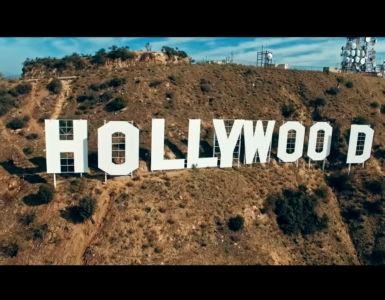Since its opening on October 1st, 1971, the Magic Kingdom has hosted countless millions of happy memories for multiple generations. The crowds were considerably smaller in the early years of the park and the lines were obviously a lot shorter as shown in the following vintage photos of Walt Disney World. Back in the 1970s, there weren’t any cast member chaperones needed to accompany characters for photos and meet-and-greets around the park. You didn’t need a FastPass to have any hope of riding a popular attraction during your visit. For the first few decades of the park, you could ride the Skyway, paddle in a real canoe, and take a wild ride with Mr. Toad.
Although the park hasn’t been around nearly as long as Disneyland on the West coast, the Magic Kingdom has a rich history of its own ever since Walt Disney conceived of what came to be known as, “The Florida Project” back in the mid-1960s. In fact, the Magic Kingdom holds the distinction of being the most visited theme park in the world, with just over 21 million visitors passing through its gates in 2019. Disneyland in Anaheim welcomed nearly 18 million visitors, making it the second most visited theme park. Not bad Walt.
While millions of visitors from around the world create special memories at Walt Disney World and the Magic Kingdom in particular today, there is something undeniably special about taking a journey back in time and getting a feel for what the Magic Kingdom was like before the crowds and before Disney became the multi-billion dollar mega corporation it is today. While there’s a lot to be excited about at WDW with the new theme parks, hotels and a host of other attractions, you’re never too old or too young to take a brief journey back and enjoy the way things were when the park was new.
Park Entrance & Main Street – Vintage Photos of Walt Disney World Capture Its Special, Early Magic

The Disney World experience starts from the minute you get on the monorail. Even before people technically enter the gates, guests are greeted with a phenomenal display of Mickey-infused horticulture. Disney’s landscape design is a part of its magic, and that aspect has not change since 1978. This same array of flowers can be seen at the Disney World entrance today.
But why the flowers? Of Disney World’s 25,000 square footage of land, 4,200 of it is dedicated to its premium landscaping. Throughout the parks, bushes, flower beds, and trees have been remodeled to impersonate classic Disney characters. The idea to include the landscaping as an integral part of Disney theming started from the original opening of Disneyland in 1955. There are over 600 Cast Members who are hired to prune and prime the shrubbery throughout the park. The horticulture employees are hired on as experts in their field as they are entrusted with planting and replanting various specious from around the world. Three million bedding plants are integrated every year and the planning that goes into the landscaping is mind-blowing.

Disney plans out its flower beds year in advance. They even bring in the plants years before the are even planted. The plants are maintained in a nursery until they are ready to be replanted into the parks. Which is crazy considering that all of Disney plants seem to be in excellent condition year-round—despite Florida’s excessive weather habits. Think about it: have you ever seen a withering rose bed at Disney World?
Today when guests visit the Magic Kingdom, it would be a miracle to see an uncrowded Main Street. However, in 1977 these guests were lucky enough to be able to stroll through Main Street, U.S.A and take in all its unique wonders.

Main Street differs from location to location. At the Magic Kingdom, this street represents a small early 20th-century mid-western town. This is in tribute to Walt Disney’s childhood hometown and is also inspired by Lady and the Tramp. At the entrance is Town Square, guests can see the “four corners” buildings that represent different architectural styles. Along the street, there are various shops that sell food and merchandise. There is a City Hall, or Guest Relations, on each Main Street along with a train station. The shops here vary from real barber shops to Disney souvenir shops such as The Emporium. This strip ends at The Hob or Central Plaza at the base of Cinderella’s Castle. The Magic Kingdom and Tokyo Disneyland are the only two Disney theme parks with Cinderella’s Castle.
Back in 1977, there were a few attractions that no longer take place on Main Street U.S.A. This includes America on Parade, Main Street Cinema, Penny Arcade, and The Walt Disney Story.
Disney theme parks are specifically known for their character-infused parades. Even today, characters from Disney’s earliest creations (such as Snow White) still make appearances in their routine daily parades. One of the first ever Disney parades was called the Main Street Electrical Parade. It wove its way through the core streets for a nighttime spector, complete with lights, floats, and classic Disney characters. The floats from this parade were recycled for reuse at Disney’s worldwide parks with the roster of characters changing throughout the years. The Magic Kingdom parade ran from June 11, 1977, to September 14, 1991.

Another well-known parade from Disney World 1978 was Mickey’s Birthday Party Parade, which celebrated 50 years of Mickey Mouse. This also would have been close to Snow White’s 41st birthday, which would have made her a prominent feature in Mickey’s birthday celebration!
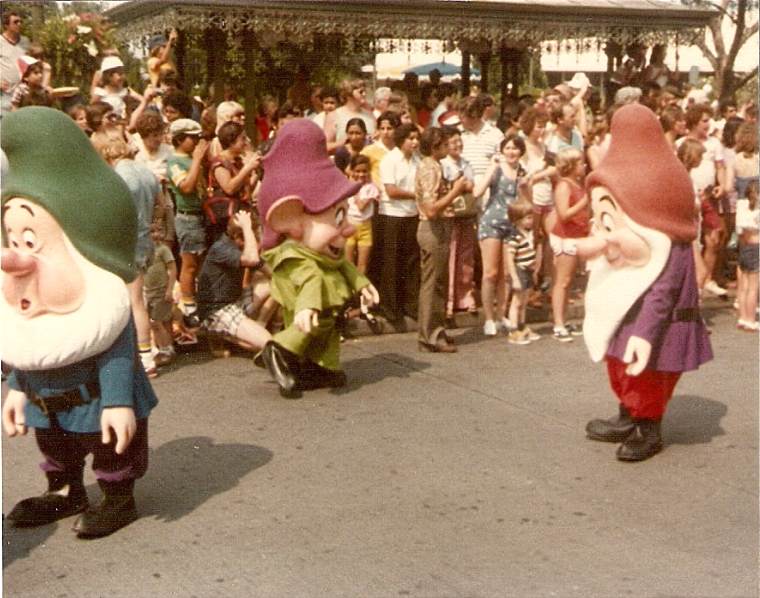
As you can see, not much has changed in the way the parades are set up for guests. It has become second nature for frequent Disney-goers to pick a prime spot (the sidewalk’s edge is best reserved for small children) to get a decent view of the parade. Guests will pack together for miles to watch the magic of this grandeur performance and stay until the very end.
As you can see here, the tradition of wearing matching T-shirts to Disney (or in this case, sweaters) has been going strong for many years. As a child, one of the most exciting experiences of going to Walt Disney World is getting the chance to meet your favorite Disney cartoons—in real life!
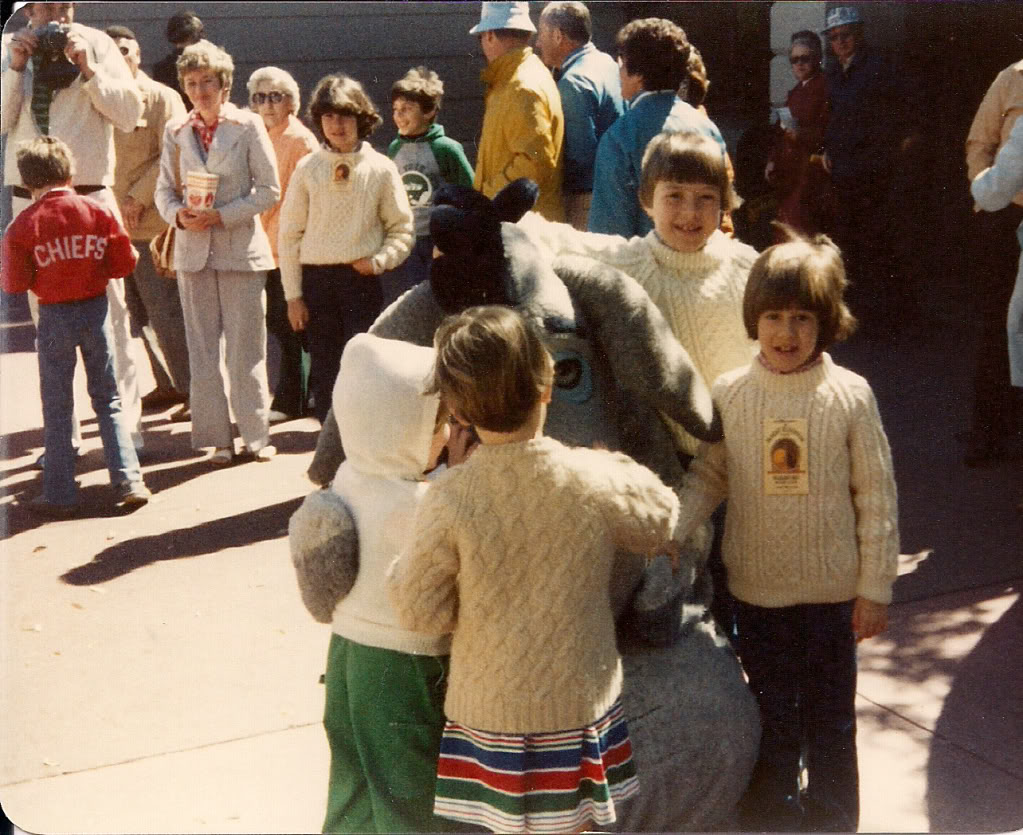
No doubt that as you got older, you became aware that these characters were simply costumes worn by Walt Disney World employees. However, it’s interesting to know that Disney is very selective about its hiring process when it comes to selecting performers for their characters. Not only are there strict appearance requirements, but the audition process can last several days.
Requirements to be a Disney character ranges from height, body build, and of course, acting skills. If you want to be Tinker Bell, but you are over 5’2” you are automatically disqualified. Same goes for those who wish to be Disney villains such as Maleficent. If you aren’t 5’9” or taller, it doesn’t matter how well you impersonate that character—you’re out.
It is a bit different for those who audition to be what are known as “furry characters” such as Eeyore here. Most Disney performers start off as fur characters. Disney performers have to study and be able to pull off impressions of characters. They also must be able to professionally represent the character and the Disney brand. This includes being able to think on their feet during meet and greets, be able to withstand the hot temperatures of the costume, and even get their characters autograph down to a T.
As you can see, even back in the 1970s those golf carts sure do come in handy!

It also seems that the cheerfulness and consistent friendly greeting were instilled in Disney employees even in its initial days. While the lands, the rides, and even the shrubbery continue to change and upgrade at Walt Disney World, the one thing the remains the same is the solidarity the Cast Members have in creating a magical experience for us all.
Disney holds high praise for its ability to uniquely shape their employees’ uniforms throughout the park. Each one is expertly crafted to model the theme of the land that each set of employees work at. Here you can see two boys posing with a Walt Disney World tour guide. Disney’s tour guides work to provide a group of guests with a unique Disney experience. Tour guides take large groups throughout the park on a seven-hour journey getting special behind-the-scenes and fun facts about Walt Disney World. These two boys probably also got early access to some of the rides!

A 1970’s tour guide, as seen above, could be found sporting a sharp blue vest over a white blouse to match their knee-high socks. Her ensemble here reflects more of the thrifty 70’s fashion scene at the time, but Disney routinely tries to modernize their employees’ uniforms. The plaid skirt highlights what would have been a popular school uniform at the time, making the Disney employee wardrobe more familiar and approachable for kids. Today, Disney World employees can be found sporting the same snazzy blue with plaid, but in reverse. Their vests are donned with the fantastic red and blue plaid with options for both men in women in the navy-blue trouser pants.

Many might know Disney’s Contemporary Resort best as one of the hotels that the monorail zips through on the way to Magic Kingdom. This photo was taken in 1976, just five years after the resort opened. It is one of the two original properties that debuted alongside Walt Disney World in 1971. This site is also known for hosting Richard Nixon’s infamous 1973 press conference. It was in this Disney resort in the Ballroom of the America’s where he delivered the infamous “I am not a crook” line about the Watergate scandal.

Disney’s properties are well-known for the unique architectural concepts, with the Contemporary Resort being a key contributor. The Contemporary Tower was built with a unique A-frame slope around the center of the building.
Besides the opportunity to see the monorail as you enjoy breakfast in the Atrium, Disney’s Contemporary Resort is also in a prime location to get a view of the entirety of Magic Kingdom (as seen above). Since this photo, the view has changed ever so slightly with attraction renovations and additions throughout the park. Another popular amenity that comes with the hotel’s view is the chance to watch the Magic Kingdom’s notorious fireworks show from various areas of the hotel.
Here is a better view that shows off the complexity of Disney’s Contemporary Resort. As you can see, the monorail runs through the center of the resort where passengers on the train can get a quick view of the building’s central Atrium.

Construction for the Contemporary Resort began just eight months before its first guests were scheduled to arrive. The design was contrived by WED Enterprises, which later became Walt Disney Imagineering. The A-frame slop was one of the first structures of the resort to be built surrounding the central elevator shaft. The skeleton of the A-frame sat at around 150 feet. While this was being built, a slew of workers were building rooms to insert into the resort at a speedy rate. They were building as many as 40 rooms per week! The rooms weighed nine tons and were then moved to the main construction site where they were individually slid into the A-frame.
Some people believe that this strange method of construction was done so that each room would essentially be removable to make renovations easier. However, this is simply a simple myth. However, this idea certainly does add on to the legend that is Disney’s Contemporary Resort.
Fantasyland – Vintage Photos of Walt Disney World Capture Its Special, Early Magic
Fantasyland is one of the original themed lands that can be found in all Disney parks. Its persona represents a Renaissance motif and is most known for carrying Disney’s most classic character attractions. This is where Cinderella’s Castle lays dominant among other staples such as Peter Pan’s Flight, Mickey’s PhilharMagic, Dumbo the Flying Elephant, It’s a Small World, and six of the other main attractions.

However, the Fantasyland guests see today is very different from this 1978 version. In 2010, construction started on a concept, dubbed “New Fantasyland” that would expand the popular area. In the four years it took to revamp this area, rides such as Ariel’s Grotto were conceived and important stations such as the Princess Fairytale Hall opened. To this day, Disney World Fantasyland attractions continue to come and go to make room for modern Disney tales. Some of today’s more popular add-ons include Gaston’s Tavern and the now notorious Be Our Guest restaurant.
The attraction seen in this photo is Mr. Toad’s Wild Ride, which closed in 1998 after almost 20 years as one of Disney World’s original attractions. There are a few rides that these guests were able to experience in this 1978 photo that is no longer in Fantasyland today:
- Mickey Mouse Revue (1971–80)
- 20,000 Leagues Under the Sea: Submarine Voyage (1971–94)
- Mr. Toad’s Wild Ride (1971–98)
- Skyway to Tomorrowland (1971–99)
- Skull Rock (1971–2011)
- Snow White’s Adventures (1971–1994)
The Disney World Skyway attraction was gondola lift that carried guests from Tomorrowland to Fantasyland. This attraction gave riders the unique ability to get an aerial perspective over these areas of the park. In this photo, you can see attractions such as Dumbo the Flying Elephant and the Prince Charming Regal Carrousel among the many restaurants and gift shops.
The Disneyland version of the Skyway opened in 1956. After several renovations, the attraction eventually closed in 1994 due to stress on the metal framework. Disney World’s Skyway was eventually removed in 1999 and has since been covered by Tangled-themed restrooms and a stroller parking area.
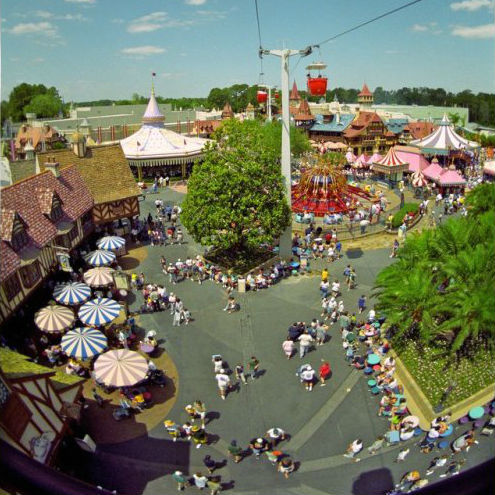
However, Disney recently announced the return of the Skyway system for the Walt Disney World Resort. The attraction has been renamed as the Disney Skyliner and will connect various Disney amenities, including Disney’s Art of Animation, Pop Century, Caribbean Beach resorts, the Disney Riviera Resort. There will also be Skyliner connections for Disney’s Hollywood Studios and the International Gateway at Epcot. The Skyliner is another aerial tram, except these vessels will be larger than those from the Skyway to accommodate more passengers. Its main focus is to act as a communal transport between the Disney World resorts.
Disney World’s Mad Tea Party has become a staple attraction in the Magic Kingdom. It was conceptualized to pay tribute to Alice in Wonderland’s Unbirthday Party scene, hosted by the Mad Hatter. Many ideas were brought to the table for this attraction, with earlier versions set with the Mad Hatter’s dinner table in the center of the attraction.

The final concept (which opened in 1971) is different from the version guests see today. For the first few months of the Disneyland attraction, the teacups spun on a solid platform before the psychedelic spiral was painted on. These teacups also did not have brakes implemented the first two years, which meant that there was no limit on how fast the teacups could spin. In 1973, the Mad Tea Party added a central teapot, which the Dormouse pops out of from time to time during the ride. They also added the colorful awning that guest can see at Disney World today to protect it from Florida’s severe weather conditions. In 1992, the attraction was again remodeled and repainted, complete with a new color scheme, music, and lanterns.

This attraction is only known as the Mad Tea Party at Disneyland and the Magic Kingdom. It is called Mad Hatter’s Tea Cups in Disneyland Paris and Alice’s Tea Party in Tokyo Disneyland. All five versions of the attraction are in Fantasyland.
It’s a Small World is a well-known staple attraction at all Disney theme parks. The gentle boat ride takes guests through a worldwide adventure, with the sultry “It’s a Small World” tune humming throughout the attraction. This attraction made its inaugural release at the New York World Fair in 1964 before moving permanently to Disneyland.

The attraction features over 300 animatronic children of different ethnicities and cultures from around the globe. They sing together all throughout the boat ride to represent international unity. The song was written by the Sherman Brothers and was influenced by the then-recent Cuban Missile Crisis. They wrote the song as a symbol of peace and harmony that the world lacked in that time period. Walt Disney is said to have loved the song so much that he changed the original name of the attraction from “Children of the World” to “It’s A Small World” after the Sherman Brothers’ song. The song has since been named the most publicly performed song in history.
Today, the entrance to this attraction has changed. While still holding onto its renaissance façade, the colorful red and blue colors have been replaced by a solid white front with the title now officially being presented as “it’s a small world” in all lower-case letters.
Adventureland – Vintage Photos of Walt Disney World Capture Its Special, Early Magic
The idea of Adventureland came directly from Walt Disney who wanted to immerse his guests in a remote jungle location.

“We pictured ourselves far from civilization, in the remote jungles of Asia and Africa.” – Walt Disney
This photo, taken just a year after Disney World’s grand opening, shows how Disney hoped to imagine a world in the 1950’s post-war Tiki era. Non-American totem poles, Pacific-influenced architecture, and animal statues can be found among the exotic vegetation in this “uncharted” area. Disney World divides this land into two separate spaces. The Arabian Village was added after the success of the 1991 animated film, Aladdin, with the magic carpet ride being added in 2001. The other sector is called the Caribbean village where the Pirates of the Caribbean attraction can be found.

The overall motif plays off of a 1930s jungle vibe which is promoted even further with the Swiss Family Treehouse. This attraction is based on the Disney film, Swiss Family Robinson. The 70 x 80-foot immersive adventure was imagined by Bill Martin and reinforced by Disney animator Wolfgang Reitherman who designed the treehouse in the film. Guests can explore the different rooms of the treehouse while rummaging through various 19th-century shipwrecked items. This attraction was closed in 1999 at Disneyland but is still going strong in Adventureland at Walt Disney World.
From 1971 to 1994, Magic Kingdom played host to an attraction called 20,000 Leagues Under the Sea in Tomorrowland. The Submarine Voyage made its first debut in Disneyland in 1959, with its first audience being President Richard Nixon, Walt Disney himself, Mrs. Disney, and a wave of U.S. Navy soldiers.

The attraction encapsulated the vibrancy of sea life by taking passengers on an underwater voyage in makeshift submarine vehicles. These vessels weighed around forty tons, though they did not function as actual boats. Instead, passengers were led into their individual seats in a room that sat below water level. It was decorated with metal paneling, rivets, and bolts with a portal hole for each guest. The warped perspective gave the illusion of an underwater journey to discover the sea’s greatest treasures.

The story begins when Captain Nemo narrates the passenger’s journey as they descend into the underwater plains around Vulcania. Passengers could see eels, turtles, and tropical fish among the unique deepwater fish that lay in the Abyss. The passengers undergo many trials and tribulations throughout this adventure. A storm would take them into the Graveyard of Lost Ships before their Nautilus would lead them to the Polar Ice Caps in the North Pole. After dodging numerous icebergs, passengers then found themselves in the lost city of Atlantis, which was laden with mermaids, treasure, and a giant squid. The catalyst happens when the submarine must escape from the tentacles of the squid. Once clear of the cave, passengers were safely transported back to Disney’s tropical lagoon.

The ride was expensive to maintain and closed without notice in 1994. It was eventually replaced by Ariel’s Grotto in 1997. Some of the ships can now be seen in the snorkeling lagoon at Castaway Cay, Disney’s private island.

An exceedingly rare view of a drastically different signage from the original Pirates of the Caribbean attraction. The innovative concept at the Disneyland location was overseen by Walt Disney himself. Sadly, he passed away three months before the attraction was completed in 1967. It was the last attraction that Disney worked hands-on for.

Disney World’s dark pirates ride opened in 1973 in Adventureland. Passengers board a weathered boat and travel through the channels of the dingy town of Tortuga. Riddled with pirates, cannon blasts, and treasures galore, Disney World guests became engrossed with the themed Yo-Ho a Pirate’s Life For Me. The temple for this attraction is housed at a golden Spanish fort called Castillo Del Morro, which was inspired by Castillo de San Felipe del Morro in the Old San Juan in San Juan. The queue leads passengers through a fort down into Pirate’s Cove. As passengers make their way down into the depths of the cove, they might notice how the left side of the queue represents Soldiers, while the right side (now the Fastpass lane) represents Pirates.
The attraction was later made into the now-famous film starring Johnny Depp as Captain Jack Sparrow in 2003. Since then, the attraction has been reworked to include Jack’s (sorry- Captain Jack) tale in the cove.
Tomorrowland – Vintage Photos of Walt Disney World Capture Its Special, Early Magic
It would be interesting to see these two toddler’s perspectives of Tomorrowland today. This photo from 1979 would make these two children over 40 years old now. Back in those times, Tomorrowland would have represented what Disney Imagineers envisioned that the future would look like. Tomorrowland was named Second Tomorrowland at the Disney World grand opening. It played as a sequel to the Disneyland Tomorrowland, which had opened 16 years previously.

Fun fact: Disneyland and Disney World both hosted their grand openings with Tomorrowland unfinished. The Grand Prix Raceway and the Skyway to Fantasyland were the only two completed attractions in this area. Because of this, Tomorrowland remained barren until plans for expansion started taking shape. Construction was prominent in this area up until about 1975 with the completion of some of today’s most spectacular attractions: The Carousel of Progress and Space Mountain.
Tomorrowland was a fixation by Walt Disney who never ceased to overlook the future of tomorrow. Disney was enthralled with the progress of technology and never wanted this area of his parks to become “Yesterdayland.” Because of this, Disney World routinely updates this land to keep up with modern times and technology. In 1994, New Tomorrowland started taking shape. The drastic changes helped to recover the modern and futuristic feel that hadn’t been modified in the two decades that had passed. Brighter colors and more attractions were added to keep Tomorrowland looking new and vibrant. Today, Tomorrowland ow sports a metallic look to keep up with the galactic landscape.
This legendary racetrack was yet another attraction that came with Walt Disney World’s park grand opening. Kids and adults alike are welcome to indulge in the go-cart “Grand Prix Raceway”, a speed track in Tomorrowland. The cars for this ride are gas powered and reach only 7.5 mph. The four-lane highway gives the illusion of a competitive car race on Disney’s personal motor speedway.
As mentioned, Tomorrowland lay vast and empty during the initial grand opening of Disney World. It wasn’t until a few years later that the Star Jets debuted in Tomorrowland, giving the area a prominent flagpole to delegate the land. This attraction is centered atop the distinguished PeopleMover; the two of which were essential integrations that were part of the vast expansion of Tomorrowland.

The Star Jets set a focal point for this area with its soaring space rockets. The Disney World version of this attraction varied slightly from the original Disneyland attraction. Its spaceships were larger and had prominent fin-tales attached the back. There are twelve vehicles circling a 20-foot arm. The rockets hold two passengers and circle up to 60-feet above the ground around the central arm. But in 1994, this ride underwent a complete renovation to go with the new generation theme, otherwise known as New Tomorrowland.
In April of 1994, the attraction was reopened as the Astro Orbiter. A futuristic iron tower replaced the central arm and various planets were added to evoke the sense of flying through space. The new framework is now a key element that projects the futuristic style of Tomorrowland. The name below the attraction changed from Wedwey PeopleMover (Wedwey being the former name for Disney Imagineers) to Tomorrowland Transit Authority PeopleMover.

This attraction was originally sponsored by Goodyear until 1999. A press-like box structure even hangs over the track because it was made specifically for Goodyear executives. It was built to give them front row seats to admire the ride. However, the Goodyear collaboration ended and was taken over by the Indianapolis Motor Speedway. Because of this change, the attraction was rechristened as Tomorrowland Indy Speedway. This sponsorship ended in 2008 and is not currently sponsored.

The cars on the track are on a guided path, though riders have access to the pedal. The Disney World version of this ride is themed to be a competitive race track, while in Disneyland, Autopia is modeled to contrive daily driving. The reason for this is because the original attraction coincided with the U.S. Highway system in the 1950s so it gave children the chance to feel like they were actually driving.
Frontierland – Vintage Photos of Walt Disney World Capture Its Special, Early Magic
This photo taken at Disney World shows one of the original Frontierland attractions. The Davy Crockett Explorer Canoes debuted at the opening of Walt Disney World in 1971. The 35-foot long boat could hold up to twenty passengers and was made of sturdy fiberglass. The free-floating canoe would take explorers from a dock in Frontierland across the Rivers of America. Two guides (commonly referred to as the frontiersmen) started the journey by giving brief paddling lessons to the guests before setting off.

Many guests, especially children, were also required to wear life jackets. This was the only attraction that has ever been propelled by Disney guests. The length of the ride actually depended on how fast the guests would paddle and how much traffic was on the river at any given time. The boat would travel around Tom Sawyer Island and the frontiersmen would point out key sights such as Tom’s cabin and a horse ridden by the Indian chief. It traveled along the same path as other water-generated rides and would dock north of Tom Sawyer Island’s raft launch.
This attraction closed at Walt Disney World in 1994. However, guests can still paddle through on this watercraft at Disneyland locations right up until preparations begin for the nighttime water shows.

Tom Sawyer Island is based off of the literary masterpiece The Adventures of Tom Sawyer by Mark Twain. Established as a Disney World attraction in 1973, it remains as an unguided adventure to this day. Not much has changed in this principal attraction, despite the growing success and renovations of other attractions. Many of the features that could be seen in this 1977 version are still a part of the attraction today. The island is still abundant in forestry with arbitrary rustic landmarks and buildings. Key components and tributes to the original novel lay within the island and continue to give guests a one-of-a-kind experience to live like Tom.

Guests start their Sawyer journey by boarding a river raft to get to the island. There are caves, bridges, Harper and Potter Mills, among many other features for boys and girls of all ages to enjoy. Tom Sawyer’s Island acts as a free-for-all playground that offers freedom and shade from Florida’s unwavering heat. It evokes a since of familiarity in adults as they are reminded of their own outdoor childhood adventures. This island also offers unique views of the park such as the dominate view of Big Thunder Mountain Railroad and The Haunted Mansion.
At the tail end of 2018, Disney World suddenly announced a two-month closure for Tom Sawyer’s Island for renovations.

Walt Disney was an innovator and a creative thinker who believed in the magic of storytelling. His disposition and theories have only blossomed into the phenomenon that is the Disney parks, but that have remained an integral part of the Disney training process. Whether it’s for character auditions, entrance employees, or horticulture experts, Disney instills the importance of magic and kindness in its Cast Members. Without this façade, Disney would not be the place it is today. With almost 50 years of offering fantasy and adventure, there is not any other place that can claim to be “The Happiest Place on Earth.”
“We keep moving forward, opening new doors, and doing new things, because we’re curious and curiosity keeps leading us down new paths.” -Walt Disney
This article was originally published on Sizzlepixs.com.

